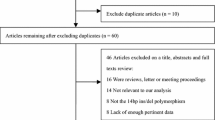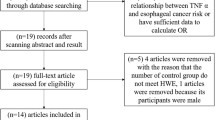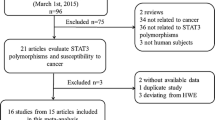Abstract
Published data on the association between lymphocyte-specific protein 1 (LSP1) rs3817198T>C polymorphism and breast cancer risk are inconclusive. Hence, we conducted a meta-analysis of the LSP1 gene and risk of breast cancer to obtain the most reliable estimate of the association. PubMed, Embase and Web of Science databases were searched. Crude odds ratios (ORs) with 95% confidence intervals (CIs) were extracted and pooled to assess the strength of the association between the LSP1 rs3817198T>C polymorphism and risk of breast cancer. A total of seven eligible studies including 33,920 cases and 35,671 controls based on the search criteria were involved in this meta-analysis. The distributions of genotypes in the controls were all in agreement with Hardy–Weinberg equilibrium. We observed that the LSP1 rs3817198T>C polymorphism was significantly correlated with breast cancer risk when all studies were pooled into the meta-analysis (the allele contrast model: OR = 1.06, 95% CI = 1.04–1.08; the homozygote codominant: OR = 1.14, 95% CI = 1.01–1.28). In the stratified analysis by ethnicity, significant association was observed in Caucasians for CC versus TT homozygote codominant model (OR = 1.25; 95% CI = 1.03–1.52) and for the recessive model (OR = 1.22; 95% CI = 1.02–1.47). There was significant association observed in Africans for CC versus TT homozygote codominant model (OR = 0.45; 95% CI = 0.22–0.92) and for the recessive model (OR = 0.43; 95% CI=0.22–0.88). Also, significant association was observed in mixed ethnicities for CC versus TT homozygote codominant model (OR = 1.12; 95% CI = 1.05–1.19). When stratified by study design, statistically significantly elevated risk was found in nested case–control studies (CC vs. TT: OR = 1.12, 95% CI = 1.05–1.19). But no significant association was observed for all comparison models between LSP1 rs3817198T>C polymorphism and breast cancer risk in hospital-based and people-based studies. When stratified by BRCA1 mutation carriers status, statistically significantly elevated risk was found in this meta-analysis (the allele contrast model: OR = 1.07, 95% CI = 1.01–1.14; the dominant model: OR = 1.09, 95% CI = 1.00–1.18). And significant association was found in the BRCA2 mutation carriers in the allele contrast (OR = 1.11, 95% CI = 1.03–1.20), the homozygote codominant (OR = 1.23, 95% CI = 1.04–1.47), the heterozygote codominant (OR = 1.12, 95% CI = 1.00–1.25) and the dominant models (OR = 1.14, 95% CI = 1.03–1.27). There was significant association between LSP1 rs3817198T>C polymorphism and breast cancer risk in BRCA1 and BRCA2 positive cohort in all comparison models (the allele contrast model: OR = 1.08, 95% CI = 1.03–1.13; CC vs. TT: OR = 1.16, 95% CI = 1.05–1.29; TC vs. TT: OR = 1.09, 95% CI = 1.01–1.16; the dominant model: OR = 1.10, 95% CI = 1.03–1.17; the recessive model: OR = 1.12, 95% CI = 1.01–1.23). In conclusion, this meta-analysis suggests that the LSP1 rs3817198T>C polymorphism is a low-penetrant risk factor for developing breast cancer but may not be in Africans.






Similar content being viewed by others
References
Parkin DM, Bray F, Ferlay J, Pisani P (2005) Global cancer statistics, 2002. CA Cancer J Clin 55:74–108
Lichtenstein P, Holm NV, Verkasalo PK, Iliadou A, Kaprio J, Koskenvuo M, Pukkala E, Skytthe A, Hemminki K (2000) Environmental and heritable factors in the causation of cancer—analyses of cohorts of twins from Sweden, Denmark, and Finland. N Engl J Med 343:78–85
Easton DF, Pooley KA, Dunning AM, Pharoah PD, Thompson D, Ballinger DG, Struewing JP, Morrison J, Field H, Luben R et al (2007) Genome-wide association study identifies novel breast cancer susceptibility loci. Nature 447:1087–1093
Lanigan F, O’Connor D, Martin F, Gallagher WM (2007) Molecular links between mammary gland development and breast cancer. Cell Mol Life Sci 64:3159–3184
Radisky ES, Radisky DC (2007) Stromal induction of breast cancer: inflammation and invasion. Rev Endocr Metab Disord 8:279–287
Latif A, Hadfield KD, Roberts SA, Shenton A, Lalloo F, Black GC, Howell A, Evans DG, Newman WG (2010) Breast cancer susceptibility variants alter risks in familial disease. J Med Genet 47:126–131
Gorodnova TV, ESh K, Yanus GA, Katanugina AS, Abysheva SN, Togo AV, Imyanitov EN (2010) Distribution of FGFR2, TNRC9, MAP3K1, LSP1, and 8q24 alleles in genetically enriched breast cancer patients versus elderly tumor-free women. Cancer Genet Cytogenet 199:69–72
Barnholtz-Sloan JS, Shetty PB, Guan X, Nyante SJ, Luo J, Brennan DJ, Millikan RC (2010) FGFR2 and other loci identified in genome-wide association studies are associated with breast cancer in African American and younger women. Carcinogenesis 31(8):1417–1423
Tamimi RM, Lagiou P, Czene K, Liu J, Ekbom A, Hsieh CC, Adami HO, Trichopoulos D, Hall P (2010) Birth weight, breast cancer susceptibility loci, and breast cancer risk. Cancer Causes Control 21:689–696
Antoniou AC, Spurdle AB, Sinilnikova OM, Healey S, Pooley KA, Schmutzler RK, Versmold B, Engel C, Meindl A, Arnold N et al (2008) Common breast cancer-predisposition alleles are associated with breast cancer risk in BRCA1 and BRCA2 mutation carriers. Am J Hum Genet 82:937–948
Garcia-Closas M, Hall P, Nevanlinna H, Pooley K, Morrison J, Richesson DA, Bojesen SE, Nordestgaard BG, Axelsson CK, Arias JI et al (2008) Heterogeneity of breast cancer associations with five susceptibility loci by clinical and pathological characteristics. PLoS Genet 4:e1000054
Yu KD, Chen AX, Qiu LX, Fan L, Yang C, Shao ZM (2010) XRCC2 Arg188His polymorphism is not directly associated with breast cancer risk: evidence from 37, 369 subjects. Breast Cancer Res Treat 123:219–225
Egger M, Davey SG, Schneider M, Minder C (1997) Bias in meta-analysis detected by a simple, graphical test. BMJ 315:629–634
Kadiyala RK, McIntyre BW, Krensky AM (1990) Molecular cloning and characterization of WP34, a phosphorylated human lymphocyte differentiation and activation antigen. Eur J Immunol 20:2417–2423
Qiu LX, Yao L, Mao C, Chen B, Zhan P, Yuan H, Xue K, Zhang J, Hu XC (2010) Lack of association between MnSOD Val16Ala polymorphism and breast cancer risk: a meta-analysis involving 58,448 subjects. Breast Cancer Res Treat 123(2):543–547
Acknowledgment
This work was supported by the Natural Science Foundation of Jiangsu Province (No. BK2010160).
Conflict of interest
None of the authors has any potential financial conflict of interest related to this manuscript.
Author information
Authors and Affiliations
Corresponding author
Additional information
Min-Bin Chen and Pei-Hua Lu contributed equally to this work and should be considered as co-first authors.
Rights and permissions
About this article
Cite this article
Chen, MB., Li, C., Shen, WX. et al. Association of a LSP1 gene rs3817198T>C polymorphism with breast cancer risk: evidence from 33,920 cases and 35,671 controls. Mol Biol Rep 38, 4687–4695 (2011). https://doi.org/10.1007/s11033-010-0603-3
Received:
Accepted:
Published:
Issue Date:
DOI: https://doi.org/10.1007/s11033-010-0603-3




